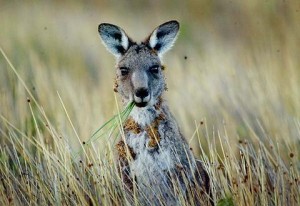
Image from http://www.smh.com.au
Did you know that Australia’s kangaroo cull is the largest land based, commercial wildlife killing in the world? And that this year alone, the federal government will permit over 5 million kangaroos to be killed for commercial purposes? I didn’t.
Australia began exporting kangaroo meat in 1959 and today the meat and skin of our national icon travels to over 55 different countries. The red kangaroo, eastern grey kangaroo, western grey kangaroo and common wallaroo are the four species currently harvested for commercial export across New South Wales, Queensland, Western Australia and South Australia.
Over the last ten years 28 million kangaroos have been killed for commercial purposes along with the by product of 8 million joeys.
President for The Australian Society for Kangaroos, Nikki Stutterby, believes the Australian people are being misled about the reasons for the cull.
“The Australian public has been conned into thinking that this industry is a necessity and is about reducing damage to farms and population control, but it isn’t,” she says.
“It is about profit and it is decimating our kangaroos.”
But it’s not just kangaroos. In the Northern Territory this year, up to 70,000 crocodiles will be wild harvested. Both the salt and freshwater crocodile are on Appendix II of CITES, which lists animals that may not be threatened with extinction now, but might become so unless trade in them is strictly regulated. Polar bears are on this same list.
In Tasmania, 60,000 brush tail possums were killed for wild harvest and crop damage between 2012- 2013. I didn’t even know Tasmania had that many possums.
So why are we doing this to our native animals?
Apparently, we have too many. It is about population control.
However the Federal government’s ‘Commercial Kangaroo Harvesting Fact Sheet’ clearly states that – “Australia has undergone severe drought in recent years, and because the primary driver of kangaroo populations is rainfall, overall kangaroo numbers in Australia declined as a result.”
Ms Stutterby reiterates that kangaroos do cease breeding in drought to avoid overpopulation and starvation.
“Kangaroos are quite capable of managing themselves within the Australian environment and have done so for 50 million years.”
“Research shows that kangaroos can only increase at a rate of around 10% per year, and once they reach equilibrium with their environment their population will stabilise,” she says.
The government fact sheet states kangaroos have been harvested and monitored for more than 25 years, during which time kangaroo populations have demonstrated a “strong capacity to recover from the regular occurrence of drought.”
This is contrary to the fact all four species of commercially hunted kangaroo now have lower population numbers then 10 years ago.
So what is the risk?
“Most Australian native animals that were hunted commercially have been pushed to the brink of extinction,” Nikki Stutterby says.
“This includes our koalas that were hunted for their fur, most species of whales that were hunted last century commercially and the Tasmanian tiger.”
Before approving any management plans that allow for wild harvesting and exportation, the Australian Government has to consider the biology, population size and conservation status of the species.
At the present time, all four species of kangaroo subject to commercial harvesting are not listed as threatened species.
A study by Hacker et al (2004) found that the effect of harvesting kangaroo populations is strongly influenced by the harvest rate (how often you harvest) and the sex ratio of the harvest (whether you cull males or females).
They found that at a constant harvest rate of mainly females, the population would decline.
So is the cull and trade regulated to ensure this doesn’t happen?
Dr Sophie Riley is a senior lecturer in the Faculty of Law at the University of Technology, Sydney. She is also the co-chair of the Teaching and Capacity Building Committee of the IUCN (International Union for the Conservation of Nature).
“Trade in native animals is regulated by a licensing system, and in the case of kangaroos, there are national codes for the humane shooting of kangaroos and wallabies.”
“There are different codes depending on whether the hunting is for commercial or non-commercial purposes,” Dr Riley explains.
A (2012) study by Boom et al reports that government agencies do not inspect carcasses at the point of kill. “Without inspections it is impossible for agencies to ensure compliance with the Code’s conditions on killing dependent young and injured adult kangaroos.”
It also discovers that enforcement of these codes is sometimes undermined by a conflict of interest because these agencies are “responsible for promoting the welfare of kangaroos and supporting the commercial kangaroo industry.”
Dr Riley believes that the efficacy of regulation depends on why kangaroo hunting has been established in the first place.
“If it is to deal with a land management problem, then decision-makers need to consider whether culling is successful, given the fact that it has not significantly reduced kangaroo numbers,” she says.
“If it is to maintain kangaroo herds for recreational or commercial hunters then it appears to have succeeded on that point. However, in both cases, hunters need to adhere to the national codes that have as their objective animal welfare concerns.
“Are these being met?” she questions.
Boom et al (2012) states that data relating to the “compliance and enforcement of the commercial kangaroo industry is limited”. They also find that prosecutions rarely occur and where prosecutions have been successful, low fines are generally imposed.
“Australian’s are being robbed of their national icon and misled about the reasons for their ongoing slaughter,” Australian Society for Kangaroos, Ms Stutterby says.
“The Australian public has never been consulted as to whether they agree with their native wildlife being slaughtered. It has remained a dirty secret.”
What does the future hold for native animals? Will profit override animal welfare and conservation? Or will kangaroos and other endemic species continue to thrive?
As Steve Irwin once said, “There is no such thing as the sustainable commercial hunting of wildlife.”
